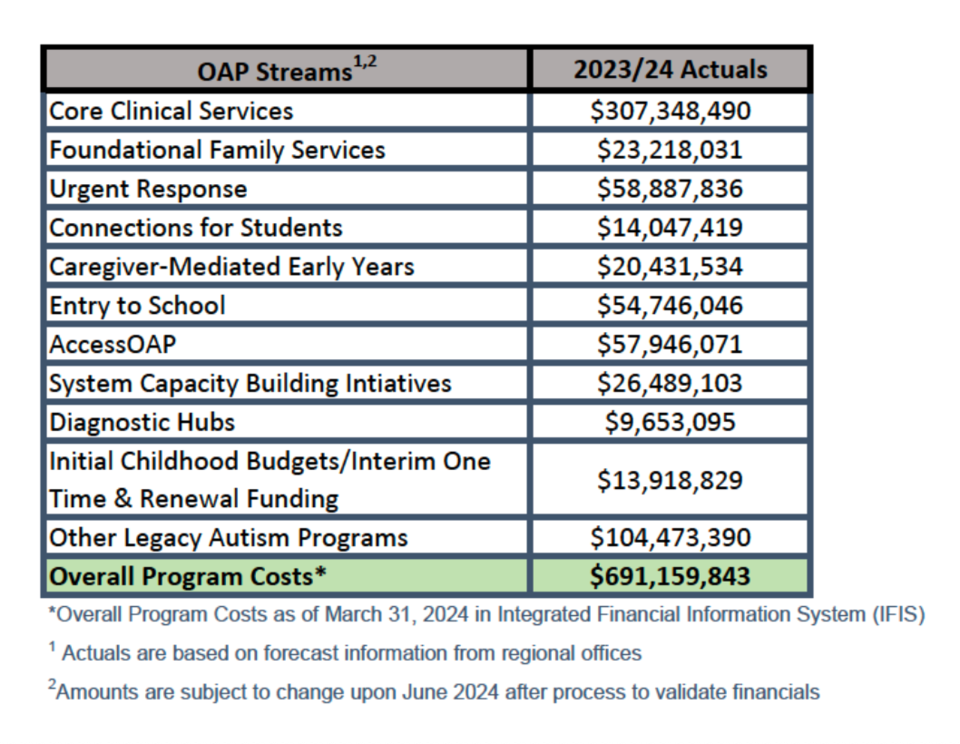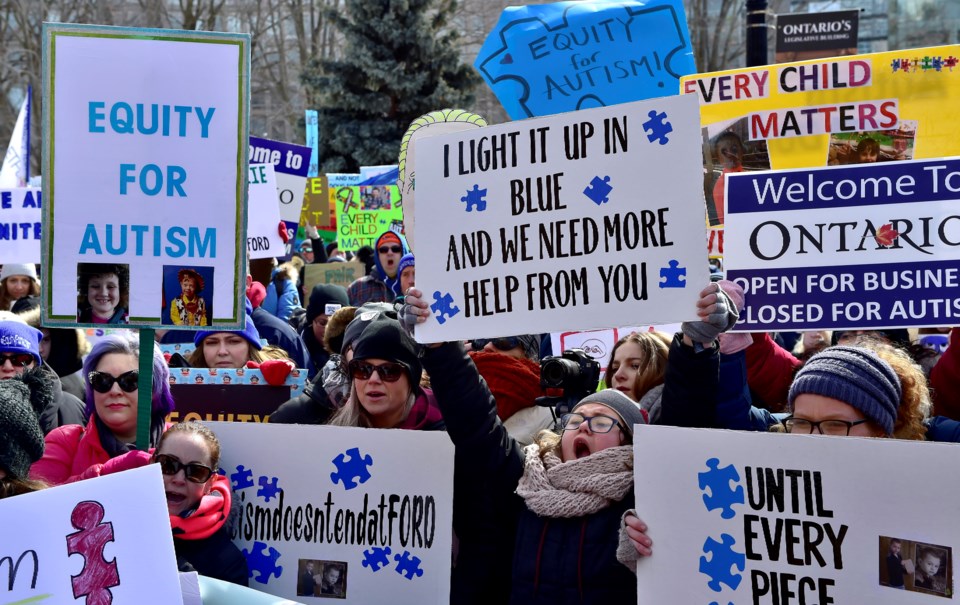EDITOR’S NOTE: This article originally appeared on The Trillium, a Village Media website devoted to covering provincial politics at Queen’s Park.
Advocates say they would like a larger portion of the Ontario Autism Program's budget to go towards core services so that more children with autism can access the therapies they need.
Their calls, which include having the education ministry take over the school-focused components of the program, follow a breakdown of program spending The Trillium obtained through a freedom of information request showing less than half of what the government spent on the Ontario Autism Program in 2023-24 went towards core clinical services — a "key element" of the province's revamped program.

"I would like to see more kids getting core services," said Alina Cameron, president of the Ontario Autism Coalition.
The obtained Ministry of Children, Community and Social Services (MCCSS) documents and a Financial Accountability Office report from June show 70,176 children and youth were registered in the OAP as of March 31 and that the cumulative total of children enrolled for core services as of that date was 20,462. But not all of these children have funding in hand, with the Canadian Press reporting last month that fewer than 15,000 children had received core services funding by the end of March.
"The way they've designed this, it's a behemoth administratively, there's a lot of red tape and I see less than half of the budget going towards the most important piece, which is core clinical services," said Cameron. "This is a clinical program and I see a lot of money being spent on stuff that's not that."
The breakdown of estimated program spending for the last fiscal year showed that of the $691.2 million spent on the OAP, around $307.3 million went towards "core clinical services," which includes applied behaviour analysis, speech-language therapy, occupational therapy and technology or other therapy equipment.
Another nearly $160 million was for other pillars of the program including $58.9 million for "Urgent Response" services, $54.7 million for the "Entry to School" program, $23.2 million for "Foundational Family Services" and $20.4 million for "Caregiver-Mediated early years."
Around 3,414 children enrolled in the "Entry to School" program while 2,577 enrolled in "Caregiver-Mediated early years" in 2023-24, the documents show. There were 18,230 families who used "Foundational Family Services" from April 1 to Sept. 30 last year and 1,943 used "Urgent Response" services from April 1 to Dec. 31.
The ministry said data for the full fiscal year for the latter two programs isn't yet available.
The documents also listed $14 million for "Connections for Students," $26.5 million for "System Capacity Building Initiatives" and $57.9 million for AccessOAP, which is a partnership between Accerta Services Inc, Autism Ontario, McMaster University and Serefin to oversee registration, intake and payments to families for the program.
"Connections for Students" is a joint program with the education ministry and supports youth transition from "OAP clinical settings" to schools, a MCCSS spokesperson said, also noting that the capacity building funding aims to help service providers hire, train and retain staff to deliver OAP services.
Another $9.7 million went to the five provincially-funded diagnostic hubs. "Other legacy autism programs" made up $104 million of the budget, which a ministry spokesperson said "includes a wide range of services that were introduced to provide supports to children on the autism spectrum and their families prior to the current OAP" including respite services, behaviour plans and more.
Around $13.9 million went towards "initial childhood budgets/interim one time & renewal funding," which were elements of the first iteration of the Ford government's autism program and supports provided while the government developed a revised program.
Cameron said she'd like the "Entry to School" program, which helps transition children entering kindergarten or Grade 1 for the first time, to be housed within the Ministry of Education, freeing up more funding for core services. The education minister's office didn't respond to a question about whether the government would consider this.
Cameron called the cost of "urgent response" services "astounding." Around 1,943 children received these services during the first three-quarters of 2023-24. While the government said it doesn't have the number for the full year, taking an average of 648 individuals receiving support each quarter would come to around $22,700 per child.
Cameron said one issue is that urgent response services provides support for a 12-week period, but sometimes the issues being tackled aren't always resolved by then.
"People are registering for this stuff because it's all they have access to," she said of the OAP supports other than core services. "They're time-limited, they're limited to certain age categories ... they're nice to have, they're not need to have. These pillars are band-aids and they're really expensive."
Core services, she added, is the "consistent care that's required by our children ... this is where we see real benefits in developmental trajectories."
Bruce McIntosh, former president of the OAC, agreed, saying that based on what the government seems to be spending on each child for "urgent response" services, it makes more sense to just move the children into core services so that they would be "getting therapy that would be lasting."
Pushing back against the government saying the program was designed by the community, McIntosh said the issue is that core services were rolled out last.
"If kids had gotten core (services) early ... not as many of them would need urgent response, right, and they wouldn't have trouble getting into school, because they'd have been learning the skills that would let them access curriculum, large groups," he said, adding that kids are likely to regress once they stop supports through the "urgent response" program.
For Margaret Spoelstra, chief executive officer of Autism Ontario, the budget breakdown captures many of the recommendations of the autism advisory panel that the government struck in 2019 to help build a needs-based funding model.
But Spoelstra, who was co-chair of the panel, said the worry for her organization is that not enough children are receiving supports.
"We share a concern that all the kids who should be gaining access to the program are not," she said, adding that addressing this involves having a broader conversation and examining more than just money for the program.
She said more focus is needed in the education system since many of the children registered for the program spend a majority of their time at school.
"So much work needs to be done in education to better coordinate and support autistic students. If that was happening, we wouldn't see the same demand on the OAP," Spoelstra said, adding that part of this involves ministries collaborating more. "Kids can get really good services in single places in the province in their schools, but it depends on the principal, it depends on the teacher, and it depends on how those local boards choose to use their funds around supporting autistic students."
Spoelstra said ensuring children who need core services get into the program as soon as they get a diagnosis is also important.
"Get those determination of needs done with those young ones and get them in the program without hesitation and wait," she said. "No kid in this province who's in preschool years should be without a program if they are not meeting developmental milestones, if they are not socializing in a way that they should be and seeing their development grow in the most typical way possible."
Funding for core services ranges from $6,600 to $65,000 depending on a child's age and their level of need.
But even so, some who receive funding aren't able to spend it due to a lack of service providers or the program not covering the services needed.
This is the case for David Vahey, who has an 11-year-old son with autism.
Last spring, his son Solomon was allocated $65,000, with the family receiving the first $25,000. Despite being eligible for a second block of funding this year, they've only been able to spend around $6,000 so far on speech-language therapy and technological supports. Vahey said they had previously tried ABA therapy, but that it "didn't work for our son, he regressed for a lot of things." Solomon is currently on a waitlist for occupational therapy and is going for swimming lessons which aren't covered under the program.
Vahey said he doesn't think the program is "needs-based" as is often stated by the government.
"There's probably some kid out there that needs the money that you guys said I could spend more than my kid," he said.
The Ford government has increased its 2024-25 budget for the program to $720 million.
